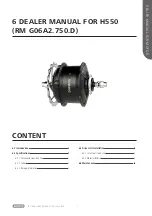
8 / 16
Attachment Commutator motors (without Ex-Protection)
ENGLI
SH
2
Description of motor
Type
Speed setting
T
h
er
mal
sw
it
ch
O
ve
rload
cut
ou
t
sw
it
ch/
o
ve
rcu
rr
ent
r
el
ea
s
e*
Int
egra
l no
-volt
rele
as
e
FEM 4070
Variable with adjustment knob
Yes
Yes*
Optional
F 457
No
No
Yes
Optional
F 457 EL
Variable with adjustment knob
No
Yes
Optional
F 458
No
No
Yes
Optional
F 458 EL
Variable with adjustment knob
Yes
No
Yes
F 458-1
No
No
Yes
Optional
Speed setting "variable with adjustment knob"
On these motors the desired speed can be variably set with an adjustment knob
(control of delivery rate).
Thermal switch
On motors with a temperature limiter the maximum temperature of the field winding is
monitored. If the maximum temperature is exceeded, the motor switches off.
Then the motor cannot be switched on again until after a longer cooling time (up to 20
minutes). Repeated overloading may damage the motor.
Overloading can result from liquids with a higher viscosity or a higher density compared
to water. If the motor switches off due to overloading, avoid that speed.
Overload cut-out switch
If the maximum current is exceeded, the motor switches off. After cooling down, the
motor can be restarted by pressing the on/off button.
Overcurrent release
If the maximum current is exceeded, the motor switches off. The motor can be restarted
immediately by pressing the on/off button.
Integral no-volt release
Motors with the integral no-volt release function are secured against accidental start-up
following interruption of the operating voltage (see rating plate U<)
Motors with the no-volt release function cannot be remote-controlled.
The motor can only be restarted by pressing the on/off button.
Attention!
Protect motors without a no-volt release against accidental
starting. The motor automatically restarts after a power failure.
Summary of Contents for F 457
Page 16: ...FB 10 98000003_05 1118 7 DEF ...


































